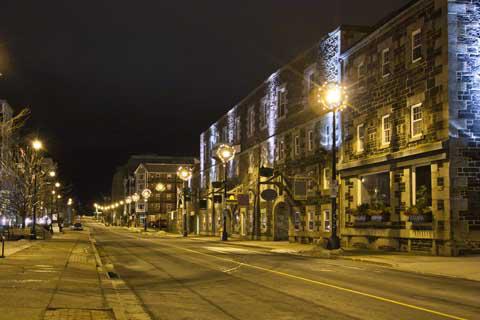Nova Scotia On a Budget
 Old Town Halifax, Nova Scotia, Canada
Old Town Halifax, Nova Scotia, Canada
When planning your trip, remember that anytime outside of June to October will be extremely frigid, and many businesses will likely be closed.
Sights
If it's animals you love, Nova Scotia has plenty of critters for you to visit. The Tobeatic Wilderness and Southwest Nova Biosphere Reserve is the largest protected wilderness area in Atlantic Canada. Spanning over five counties in southwestern Nova Scotia, the Tobeatic is home to nine rivers and over 120 lakes. Pack a lunch and enjoy an afternoon of canoeing and animal watching. Keep your eyes opened for the chance to see moose, black bears, flying squirrels, bald eagles and more.Another option is to visit Brier Island in the Bay of Fundy. This unique spot is full of marine life including whales, migrating birds and seals. It is not unheard of to spot rare and endangered plants in this area, as well, as this region is mostly untouched by man.
If human history is more your style, take a trip to the Louisburg National Historic Site. Spend the day letting the costumed tour guides tell you stories of how in 1744 this area was built to protect French interests and served as a base for cod fishing.
The Cape Breton Highlands National Park, and the surrounding area on Cape Breton island are not to be missed. This rustic and scenic area is full of dramatic shorelines, small quaint towns, and cozy bed and breakfasts.
Regions
The province of Nova Scotia is divided into several regions known as Cape Breton Island, Halifax Regional Municipality, Annapolis Valley, Cumberland County, South Shore, Northumberland Shore, and Yarmouth and Acadian Shores.Activities
There are several bike tours available along popular areas like Cape Breton's Cabot Trail and the Peggy's Cove Lighthouse route. When riding past, be sure to admire the charming lighthouse sat on granite boulders as the waves crash below. Today, the lighthouse serves as a post office but there is tourist information and a restaurant inside.A scenic drive can be made by heading south from Halifax towards Peggy's Cove and beyond, all the way down to the southern end of the island. Depending on how much time you have available, follow the coastal roads through all of the small towns along the shore. Each one offers historical buildings, restaurants, bed and breakfasts, small harbors full of fishing boats, and the occasional beach. Highlights include Peggy's Cove, Lunenburg, and the LaHave Islands.
When you're done with that, consider a quaint shopping trip in Mahone Bay. Known as the "sunniest town on the coast," Mahone Bay is full of colorful buildings from the 19th century full of local crafts for you to browse and buy.
If it's a little more adventure you're after, take a trip to Maitland for a day of rafting the tidal bore in an inflatable dingy. If you time it out to the right moon phase, you could be in for the most thrilling ride of your life.
Food and Dining
Given Nova Scotia's interesting mix of cultures, there are dishes of almost every influence. Some dishes can not be missed, though. The donair, based on a Turkish dish, is a spiced beef with tomatoes and onions doused in a sweet white sauce and wrapped up in a warm pita. Many will compare it to a gyro, but the sweet sauce is what makes the donair special, and they are available in most diners and pizza places in Nova Scotia.If you're packing snacks for your day at Tobeatic, grab a little dulse. Made from local seaweed, this snack is a treat special to this area.
Transportation
To travel around Nova Scotia it is recommended you have your own car. The highway system here is divided into three sections. Highways 1 to 99 are the original main roads of the region. They connect everything within the province. These are usually two lane roads that run through villages and towns. Highways 101 to 199 are expressways. These provide the faster route, but much like I-95 in the US, these roads don't provide much scenery. These roads typically run parallel to highways 1 to 99, but are four lanes and less appealing to cyclists. Highways 201 to 399 are minor highways through the province.There are more local paved roads, and scenic trails marked by specific signs. Nova Scotia's layout is pretty simple, but foreigners should always use a map or GPS. Be cautious of conditions in the winter, especially on smaller roads.
Related:
Looking for a party hostel in Montreal or Vancouver?
Traveling alone to Toronto or Montreal?

 Budget Your Trip is all about finding out how much everything costs so that you can travel cheaper and longer. Created by avid travelers Laurie and Bryan, our goal is to help you plan your next trip on the right budget. With average daily travel costs that are calculated from the budgets of real travelers, plus an analysis of hotel and tour prices, you can find out how much money you need to plan your next adventure. We also have plenty of travel advice, accommodation reviews, and activity suggestions.
Budget Your Trip is all about finding out how much everything costs so that you can travel cheaper and longer. Created by avid travelers Laurie and Bryan, our goal is to help you plan your next trip on the right budget. With average daily travel costs that are calculated from the budgets of real travelers, plus an analysis of hotel and tour prices, you can find out how much money you need to plan your next adventure. We also have plenty of travel advice, accommodation reviews, and activity suggestions.